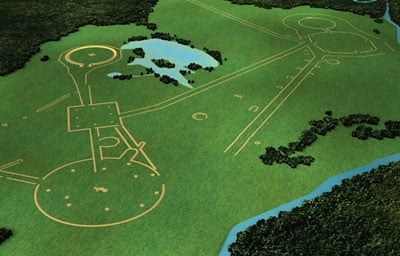
These burial mounds amaze me
Looking at the Pharr Mounds on the Natchez Trace Parkway, I couldn’t help but compare them to the prehistoric earthworks in my hometown, Newark, Ohio. Built over 2000 years ago by the Hopewell tribe, the Newark Earthworks are the largest set of geometric earthen enclosures in the world. In the entire world.
Look at the map to the left for a square at about 3:00. The enclosure is so large that the Great Pyramid in Egypt would fit comfortably within it.
See the octagon at roughly 11:00? Four Roman Coliseums would fit inside. Stonehenge would fit within the small circular enclosure located at the Octagon’s southeastern gateway (not the large circle attached to the Octagon at about 8:00, which covers 20 acres).
This rendering makes the entire system easier to see. In real life, the city of Newark has been built all around the mounds. As a matter of fact, a golf course is on the Octagon.
Very little is known about how these mounds were incorporated into the lives of their builders, the now-extinct Hopewells, but that aside, they must have been great geometrists. The mounds are spread out over such a large region that, to gain perspective, you must see them from the air. These photos will show you what they look like from the ground. If you want a real treat, check out the Great Serpent Mound about an hour away.
Let’s think about this. The Hopewells built something so huge that they, themselves, would never be able to see them in their entirety. Unlike the Egyptian pyramids or Stonehenge, which rise vertically, the Hopewells would have needed a means of flight to survey and appreciate their work. Were they designing for their gods’ (or God’s) viewing pleasure?
The earthworks seem to be a metaphor for living your best life, in spite of the limited audience. Sometimes we are called to feats that will only be apprehended in the fullness of time. Whether or not today is a day for great feats, every day is a day for living our best lives.
The Watchful One bears witness.

